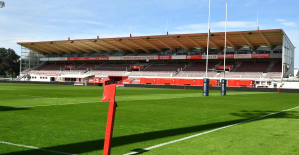some of the buyer at Edeka, Rewe or Metro in Berlin and many of Berlin's Restaurants in the Two-star chef Tim Raue will have lately wondered: There's floor-to-ceiling glass display cases, which at first glance look like typical supermarket are on a wall in the sale-freezers. But therein product is not finished, but it is to grow herbs and salad in the water tanks – apparently completely without sunlight and without soil. Twice a week two "gardeners come in", open the high-tech greenhouse, cultivate, harvest and transfer the goods directly to the sales counter.
The display cases has drawn up the 2013 founded the Berlin Start-up Infarm. It is dedicated to the "Indoor Farming": Instead of rural fields, the employees grow vegetables in the middle of the city, in warehouses or in the house of the customer who sold the plants or processed. The necessary High-Tech greenhouses developed by Infarm and rents – office care and harvesting of Restaurants and super markets. Also canteens, schools or hospitals, they wanted to win for the concept "anywhere, where fresh, healthy food, or are consumed are purchased," says co-founder Osnat Michaeli.
growth and even taste taxes
specifically Now vegetables, fruits, and herbs from greenhouses are nothing New. The New to the modern Indoor Farming, also known as "vertical farming", is that these greenhouses are now on several floors and fully-automatically with different sensors for proper ventilation, temperature, and nutrient content of the water. "First of all, the artificial lighting, which has become by cultivation on several floors vital has made, in recent years, tremendous progress," says Matthias Arlt from the Max-Planck-Institute for plant physiology in Potsdam. With newly developed LED lamps let the sun light is not only adequately replace, you can optimize the light is more even and individually to the needs of various plants in various stages of development to adapt. Growth and even taste can be selectively controlled. Therefore, artificial light is now even better source of energy for the cultivation of plants.
before Indoor Farming compared to conventional agriculture a number of advantages: In closed spaces, there are hardly any problems with pest infestation, no pesticides need to be used. Because the conditions are carefully controlled, the plants will grow better in General, even in the Winter Harvests are possible. The land and water consumption is much lower. It is regional – in the city – produced. Long transport from distant countries to have out-of-season fresh vegetables will be unnecessary. This saves a lot of climate-damaging emissions.
cheap, but it is not counter watery
The high costs, especially energy costs. Greenhouses with lighting and irrigation systems need a lot of power and if it doesn't come from renewable, but fossil energy sources such as coal or petroleum, is charged to the climate. Also, some blowing leaves house vegetables taste to your choice. Tomatoes from the traditional Dutch or Spanish greenhouses are often cheap, but also not too watery.
In the past few years has made the research progress to overcome these disadvantages. "So far, fluorescence were used for the lighting, usually fluorescent tubes or lead-halide lamps are used, which represent the full spectrum of light," says Matthias Arlt. As a result, the plants get the necessary energy, the lamps devour but also tons of power. That is exactly where modern LED-light technology helps. And not only because it is generally more energy-efficient. "Recently, it is also possible that with LEDs, only certain areas of the light spectrum to cover," says Arlt, "namely, exactly those that the Plant actually needs." In General, only parts of the spectrum in the blue, red and infra-red range. LEDs that emit only those colors, save additional power.
More infrared light gives Basil a sharp Note
in Addition, they offer the possibility to vary the combination of light colors and the intensity of the radiation. Because in the course of your life – as a seedling, grow up, or in the maturity stage, plants have different needs. Who knows this exactly, you can create a rule in the right light recipes and almost unlimited control of how the plants are to thrive: "It is not only your growth, but also their ingredients and the taste," says Jasper the Best, of the developed those recipes. His Team from the Dutch University of's-Hertogenbosch has found that red light will determine the day-night rhythm of the plants and the pace of growth significantly. Blue light provides energy to convert water and carbon dioxide by means of Chlorophyll grape sugar. Too much of it can be the vegetables, while, in turn, smaller grow, but the content of vitamins and other healthy ingredients, such as polyphenols. "The Basil more infrared light, there is a sharp Note. As well, you can make radish is sweeter,“ added the Best.
The plant defense substances
form a Valuable and taste-enhancing ingredients to produce plants under Stress triggered by UV light, Wind, pests. "The plants then form defensive substances or grow compact, to address," says Matthias Arlt. "Often this is to the detriment of the revenue." The adjustment of light and other growth conditions is a complex matter. You have to weigh whether you'd prefer to increase the yield or taste.
the nutrients that the plants pull from the soil also play a role. Indoor Farming can dispense with potting soil, a simple substrate made of coir or hemp fiber soaked in a nutrient solution, enough.
In the past few years, have more developments to much better products from the greenhouse tasting led, says Matthias Arlt. Don't be exhausted the potential, but still. The research is still in its infancy. Particularly in Germany. A leader on the territory of other countries.
operators are often High-Tech-companies
In the densely populated and arable land-poor Japan, there are already several hundred large Indoor farms. A majority of them are already switched to LED lighting. The operators of these farms are often High-Tech companies such as Sharp, Panasonic and Fujitsu.
In the Netherlands, is also researched a lot on the topic. Even some of the farmers have switched their production partially. The lettuce farmer Mark Delissen of Beesel, about produces million heads of lettuce for the English and German market. He uses the Indoor LED method, at least for the rearing of the seedlings: In a 800 square meter large hall they thrive on seven floors. With LED lighting you are within 30 days, to the extent that, in normal greenhouses with natural light implemented. "In the Winter it was always a Problem to get enough seedlings. Due to the short days, you needed three times longer, until we were able to implement them.“ Greater security of supply, consistent quality, and no crop failures on the weigh-in for Delissen the additional cost. The light technique will still be effective, he could also change in the normal greenhouse for Vertical farming.
In the United States, the company produces "80 Acres of Farms" in Cincinnati already in the 100 tonnes of herbs and vegetables per year, in a 1100 square foot former warehouse – a lot of for which you would need in conventional farming, is about 324.000 square meters of Land. The spinach waxes in a quarter of the time that you need on the field, says company boss Mike Zelkind. And the production will always be more efficient, especially thanks to the development of the LEDs: "In the past three years have halved the cost for lighting and the energy efficiency is doubled." Business is booming: 80 Acres Farms plant in the suburb of Hamilton is already more than ten times as large, fully automated Farm.
Also Infarm in Berlin is growing. To the three founders to Osnat Michaeli, meanwhile, more than 150 employees. Until the middle of next year, you want to rent out to the thousands of your small Indoor farms in Europe.
Also for private households, there are matching LED lamps
can Now be even even Indoor farmers: the Case of Ikea there is a small shelf system with a special LED-light-bars for the kitchen to grow herbs and salads at home and also in the Winter. The System is not safe as optimized as in the expensive High-Tech equipment, "but it works quite well," says Matthias Arlt.
Conventional agriculture is not a substitute for Indoor Farming. "LED systems are so expensive that they are worthwhile only for high-quality plants," says Arlt – herbs, vegetables and fruits, the high prices per weight and density are to grow. For mass-produced goods such as potatoes, cereals, rice or Corn so large volumes and surfaces are required, a Switch to Indoor Farming, results for the time being, no sense.
More aboutword of mouth - the pleasure-the Interview "for Christmas I play the pregnant Mary"
Susanne LeimenstollGreat potential for the Indoor-Farming snooze but plants in cultivation of Medicinal. Because out there on the field, the amount of active ingredients per Plant varies with environmental conditions. The Drug works, therefore, sometimes better, sometimes worse. "Due to the precise control of the growth conditions in Indoor Farming but also the concentration of the active substances control," says Arlt. Herbal medicines could be reliable. And high energy costs with pharmacist-prices anyway.

 United States: divided on the question of presidential immunity, the Supreme Court offers respite to Trump
United States: divided on the question of presidential immunity, the Supreme Court offers respite to Trump Maurizio Molinari: “the Scurati affair, a European injury”
Maurizio Molinari: “the Scurati affair, a European injury” Hamas-Israel war: US begins construction of pier in Gaza
Hamas-Israel war: US begins construction of pier in Gaza Israel prepares to attack Rafah
Israel prepares to attack Rafah Spain is the country in the European Union with the most overqualified workers for their jobs
Spain is the country in the European Union with the most overqualified workers for their jobs Parvovirus alert, the “fifth disease” of children which has already caused the death of five babies in 2024
Parvovirus alert, the “fifth disease” of children which has already caused the death of five babies in 2024 Colorectal cancer: what to watch out for in those under 50
Colorectal cancer: what to watch out for in those under 50 H5N1 virus: traces detected in pasteurized milk in the United States
H5N1 virus: traces detected in pasteurized milk in the United States Private clinics announce a strike with “total suspension” of their activities, including emergencies, from June 3 to 5
Private clinics announce a strike with “total suspension” of their activities, including emergencies, from June 3 to 5 The Lagardère group wants to accentuate “synergies” with Vivendi, its new owner
The Lagardère group wants to accentuate “synergies” with Vivendi, its new owner The iconic tennis video game “Top Spin” returns after 13 years of absence
The iconic tennis video game “Top Spin” returns after 13 years of absence Three Stellantis automobile factories shut down due to supplier strike
Three Stellantis automobile factories shut down due to supplier strike A pre-Roman necropolis discovered in Italy during archaeological excavations
A pre-Roman necropolis discovered in Italy during archaeological excavations Searches in Guadeloupe for an investigation into the memorial dedicated to the history of slavery
Searches in Guadeloupe for an investigation into the memorial dedicated to the history of slavery Aya Nakamura in Olympic form a few hours before the Flames ceremony
Aya Nakamura in Olympic form a few hours before the Flames ceremony Psychiatrist Raphaël Gaillard elected to the French Academy
Psychiatrist Raphaël Gaillard elected to the French Academy Skoda Kodiaq 2024: a 'beast' plug-in hybrid SUV
Skoda Kodiaq 2024: a 'beast' plug-in hybrid SUV Tesla launches a new Model Y with 600 km of autonomy at a "more accessible price"
Tesla launches a new Model Y with 600 km of autonomy at a "more accessible price" The 10 best-selling cars in March 2024 in Spain: sales fall due to Easter
The 10 best-selling cars in March 2024 in Spain: sales fall due to Easter A private jet company buys more than 100 flying cars
A private jet company buys more than 100 flying cars This is how housing prices have changed in Spain in the last decade
This is how housing prices have changed in Spain in the last decade The home mortgage firm drops 10% in January and interest soars to 3.46%
The home mortgage firm drops 10% in January and interest soars to 3.46% The jewel of the Rocío de Nagüeles urbanization: a dream villa in Marbella
The jewel of the Rocío de Nagüeles urbanization: a dream villa in Marbella Rental prices grow by 7.3% in February: where does it go up and where does it go down?
Rental prices grow by 7.3% in February: where does it go up and where does it go down? Even on a mission for NATO, the Charles-de-Gaulle remains under French control, Lecornu responds to Mélenchon
Even on a mission for NATO, the Charles-de-Gaulle remains under French control, Lecornu responds to Mélenchon “Deadly Europe”, “economic decline”, immigration… What to remember from Emmanuel Macron’s speech at the Sorbonne
“Deadly Europe”, “economic decline”, immigration… What to remember from Emmanuel Macron’s speech at the Sorbonne Sale of Biogaran: The Republicans write to Emmanuel Macron
Sale of Biogaran: The Republicans write to Emmanuel Macron Europeans: “All those who claim that we don’t need Europe are liars”, criticizes Bayrou
Europeans: “All those who claim that we don’t need Europe are liars”, criticizes Bayrou These French cities that will boycott the World Cup in Qatar
These French cities that will boycott the World Cup in Qatar Archery: everything you need to know about the sport
Archery: everything you need to know about the sport Handball: “We collapsed”, regrets Nikola Karabatic after PSG-Barcelona
Handball: “We collapsed”, regrets Nikola Karabatic after PSG-Barcelona Tennis: smash, drop shot, slide... Nadal's best points for his return to Madrid (video)
Tennis: smash, drop shot, slide... Nadal's best points for his return to Madrid (video) Pro D2: Biarritz wins a significant success in Agen and takes another step towards maintaining
Pro D2: Biarritz wins a significant success in Agen and takes another step towards maintaining


















